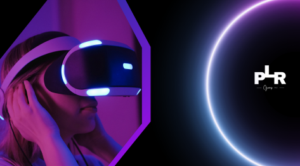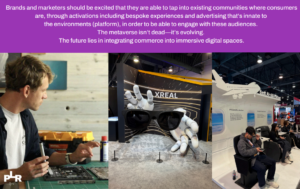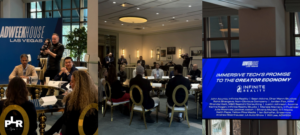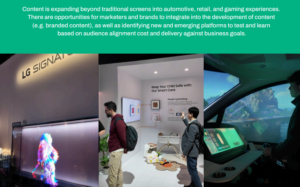CES 2025 Top Marketing Trends


OVERVIEW
At CES 2025 (Jan. 7-10), things felt different.
Wildfires raged in Los Angeles, while technology giants like Meta shared updates that threatened to overshadow the exhibitors, brands, and marketers that descended upon Las Vegas for the annual trade show.
According to the Consumer Technology Association, CES “drew in 4500+ exhibitors & 141K+ attendees, including 6K+ media” which shows the resilience of the event. What was clear was the impact of media and marketing on the Consumer Electronics Show. From Adweek House thru the Aria, marketing’s presence was felt beyond the glitzy parties, often driving conversation at the trade show. However, the energy, exhibitors, and brands on the ground provided plenty of tech news and discussions.
This year’s highlights from CES 2025, include:
- Gaming (e.g. hardware)
- Artificial Intelligence (e.g. smarthome & headsets)
- Content (e.g. Adweek House)
- Entertainment (e.g. SONY & Barbie)
Key Takeaways
- Overall there were mild tech advancements but noticeably larger brand presences, e.g. Delta bringing American Express style magic to the conference and customer experience through the lens of innovation with new tech partnerships announced with Uber to drive loyalty as well as “Delta Concierge” (#GenAI personal assistant) coming in ’25 to give guidance and recommendations to its customers
- Gaming was THE most exciting area of the show floor, showcasing haptic technology, hardware (VR/AR), and many advancements for immersive experiences in and out of the metaverse
- Artificial Intelligence continues to be dominant. If 2024 was the year of inking partnerships (e.g. OpenAI), 2025 is predicated on the feasibility and value of varied products and platforms that tap into AI, and if/how it can service the consumer, e.g. LG’s Life’s Good activation
- Adweek House held poignant discussions around how marketing and media are trying to keep up with expected pace of innovation while tech infrastructure is simply not there. This was discussed as relevant to interoperability, KPI alignment and customer experience; there were many interesting points raised about the role of tech in driving brand and agency decisions
- Legacy tech giants are focused on content, entertainment properties, and IP with less of an overt emphasis on the hardware which is part of their legacy. This includes brands like SONY touting Lego IP and HP showcasing Barbie at its footprint

Gaming
The reason gaming was such a popular footprint at CES is because when you think about immersive technologies whether it’s Artificial Intelligence (AI), Augmented Reality (AR), Virtual Reality (VR), or Cross Reality (XR), and tapping consumers within environments where it’s possible to have these immersive experiences, gaming specifically provides this at scale (already).
We see this thru role play games (e.g. Asgard’s Wrath, Baldur’s Gate, Zenith), Roblox and other metaverse adjacent experiences where you have a large swath of young audiences that are comfortable in these environments and seek out new hardware and software to be able to amp up their experiences.
At CES this was clearly on display via haptic hardware, headsets and other products. Some standouts included:
- Project Arielle: Delivers a steady stream of cool/war air depending on the player’s needs
- XReal: Great visuals, ease of use, ability to go between 3D/AR and more without the clunky head gear of a Vision Pro
- Mudra Band: The Neural Wristband leverages proprietary sensors and AI algorithms to allow users to interact with their devices hands-free, The Mudra Band was even awarded a CES 2025 Innovation Award in the XR Technologies & Accessories category
Additionally, these relevant technologies are fueling immersive shopping experiences, with a focus on blending hardware and digital experiences. Retailer MCM showcased a virtual retail space via Caliverse: bridging the gap between digital and physical shopping.

Artificial Intelligence
AI was dominant and everywhere.
In 2024 we saw a myriad of partnerships (e.g. OpenAI among others), mainly benefitting the media industry while products were adopting AI use cases. What transpired at CES was direct links between technology and how consumers can benefit from the AI integrations.
For example, LG’s smarthome concept (Good Life) showcased how AI can service petcare, your personal dietary needs, as well as tell you if you are dehydrated using bed sensors. Similarly within the “health” pillar for AI, Dassault Systèmes showcased how it taps into AI for Virtual Twins for precision insights that enable life-saving interventions and proactive care, and much more.
AiMe (Artificial Intelligence powered robot) that taps into ChatGPT for interactive functions like Q&A, recordings, and entertainment, it but feels reminiscent of an Alexa, albeit in cuter packaging.
Taking a step back you see how AI can help the farming industry, thru John Deere and others. Overall AgriTech is ripe for AI integration to optimize food production, field conditions and drive sustainability.
Unfortunately, little was discussed in relation to AI & sustainability, despite the known resource requirements for keeping these systems going, and that’s something that could have made for an interesting deep dive given the prevalence of AI at CES

Content (Marketing)
“Media and marketing have taken the spotlight at CES because they control the money, and now it’s about transactions vs. innovation.” (The Verge Podcast)
The marketing and media conversations taking place at CES brought technologists and marketers closer together and this dynamic allowed for transparency around the frustration that is felt on both sides. Whether at the Aria, Adweek House, or late night discussions with clients, the role of marketing and the (true) cost of doing business was up for debate. The focus at CES 2025 was on transforming consumer experiences, not just transactional interactions. Marketers must think beyond conversions to create long-term engagement and brand loyalty.
Several key concepts emerged:
- Open Internet
- Walled gardens (Google, Apple, Meta) continue to control the flow of consumer data, stifling innovation
- The open internet requires better attribution models to ensure that ad dollars reach publishers effectively
- Challenges:
- Media buyers and brands need to shift from “easy” attribution models to purposeful spending
- Brand safety concerns persist, with traditional publishers often being deprioritized in favor of social platforms
- Media Fragmentation
- Media consumption is no longer confined to traditional or linear platforms
- Consumers don’t distinguish between streaming, linear TV, or social platforms—they see it all as “TV”
- Data must move from outdated demographics to behavioral insights to create personalized experiences
- Trends to Watch: Interoperability between platforms and data ecosystems is critical for future success
- Media and marketing partnerships must become more flexible and strategic
- Agencies and platforms must work together to create seamless, engaging experiences
“We need the tech, data, and creativity to work better together.” — Michelle Aragon (Spectrum Reach)
- Immersive experiences
- When we think about the internet, we can view it many ways, ultimately focused on creating specific outcomes:
- Web 1: Destination (audiences land on a page for specific information)
- Web 2: Scale (audiences interact within specific environments, e.g. Meta/Roblox)
- Web 3: Personal Experience (audiences become focal point, regardless of destination)
- What this means then is if we have learned over the past several years that consumers feel apprehensive about being an avatar in a specific environment to interact with friends & brands or others, then it’s more likely that you’re able to engage them in immersive experiences by including AI/AR and other activations within a trusted website and or environment that they know
- There is a shift from “destination” platforms to personalized, immersive experiences (Web 1 to Web 3 evolution)
- Consumers demand authenticity and seamless integration of virtual and real-world experiences. Creators have learned to bridge this gap for consumers and this adaptability has proven to be a growth area for them
- When we think about the internet, we can view it many ways, ultimately focused on creating specific outcomes:

Additional Key Speakers/Insights:
- Will Lee, Adweek CEO:
- The shift to immersive, personal experiences is essential for future engagement
- Silvana Moretti (11:11 Media):
- Creators are shaping brand narratives, but they want ownership of their data
- Keith Pape (Yellow Brick Agency):
- Don’t repeat past mistakes with metaverse audiences
Entertainment
In addition to BIG SCREEN TVs, CES 2025 showcased:
- In-car entertainment:
- Vehicles as entertainment hubs – for entertainment, work, and relaxation
- Biometric data: Vehicles can use biometric data to tailor the experience to the driver’s mood
- Entertainment properties like Barbie (Mattel) and Crunchyroll (SONY) are leading the charge in immersive storytelling across platforms
- Immersive audio systems:
- Xperi demonstrated immersive audio systems for smart TVs and in-car entertainment
- THX spatial audio:
- A technology that can provide a surround sound experience with a stereo setup
LG’s “Stand By Me 2” (portable smart TV) — showed how you can have wall art that becomes an “activity” (e.g. drawing) and also function as a streaming device, e.g. view Netflix. This product signals portability, whereas we usually think of a mobile device, the focus is on how the home is not stagnant and can in fact deliver on “fun” and entertainment.
Discover the future of innovation and technology by checking out the CES 2025 Trends Report! Dive into the top trends shaping the industry by watching the full video here. Don’t miss out on what’s next!
How to Reach the Author
Marketing & Innovation Consultant

